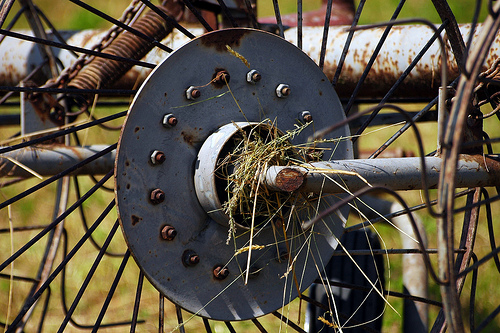I always feel a little guilty, heading out with a camera and my backpack of accessories to take a walk in Jablonka and photograph people who are putting in a normal day’s work in the field that is harder than I do most days of my life. That is why I always hesitate to approach. A massive zoom lens — call it the coward’s approach.
fortunately, hard-working Poles are not the only attraction. Much of the farm work here — such as turning hay on the fields for drying — is done with somewhat antiquated machinery by commercial/industrial Western farm standards. The machines are rusty but elegant reminders that not all heavy machinery needs computer chips and miles of cables. A few rusty springs will do just fine.
At first, one might say, “There is no comparison to the scale of large, commercial Western farms,” and that’s correct, partially. But when you see how Orawians load a trailer with hay, it puts questions of scale into proportion.
Remember: this trailer was load manually: one or two guys on the ground tossing up pitchfork-loads of hay to one or two guys (or women, or even adolescents) standing on the growing pile. At least that’s how it ends. The wagon actually has a device that forks the hay into the wagon bed automatically, but one doesn’t make wagon loads this high by letting machines do all the work.
The odd thing about the fields they’re working is their shape: long and narrow. Most of them are no wider than thirty or forty feet, but they are often three or four times that long.
It’s the result of generations of inheritance: dividing the land to pass it on to further generations creates not a checkerboard but, well, yes a checkerboard, but out of some Dali painting, where the dimensions and shapes of everything are exaggerated and warped.
The big mystery: with so many fields crammed side by side, how does anyone know anyone’s borders? I go out for a walk and find one field’s hay cut, neatly put into piles; the neighboring field is wild with grass and flowers. How does the owner know where his land stops and his neighbor’s begins?
“They just know,” I’m told.
Apparently, though, some have gone to the cost of having surveyors come out and set boundaries.
Others use less technologically-dependent methods.







0 Comments